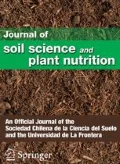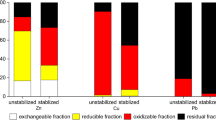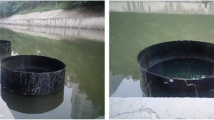Abstract
When the high-density sludge (HDS) process is adopted to treat copper mine wastewater, a large amount of sediment is generated. Sediment can be used as the guest soil after fertilization and restoration, which plays a role in the ecological reclamation of mines.
To explore the effect of different phytoremediation approaches on the physicochemical properties of HDS sediment, the untreated sediment was employed as the control group, whereas sediments repaired by six kinds of plants, including slash pine (Pinus elliottii Engelmann), Chinese white poplar (Populus tomentosa Carr.), black locust (Robinia pseudoacacia), Photinia × fraseri, Ligustrum quihoui, and Ligustrum japonicum Thunb, were selected as the test groups. Then, the water content, pH, organic matter, total nitrogen, total phosphorus, total potassium, available phosphorus, and available potassium contents in the sediment samples were analyzed.
The results showed that, among the six experimental groups, the L. japonicum group achieved the most significant effects on sediment pH and total nitrogen content. Meanwhile, the slash pine group improved the sediment organic matter content, available phosphorus content, and available potassium content to the greatest extent. The black locust group had the most significant effects on the sediment total phosphorus content.
As discovered from the grey correlation analysis results, slash pine has the best comprehensive effect of improving the physicochemical properties of sediment among the six plants, followed by black locust, Photinia × fraseri, Chinese white poplar, Ligustrum quihoui, and Ligustrum japonicum Thunb.



Similar content being viewed by others
Data Availability
All data included in this study are available upon request by contact with the corresponding author.
Code Availability
Not applicable.
References
Acosta JA, Abbaspour A, Martínez GR, Martínez-Martínez S, Zornoza R, Gabarrón M, Faz A (2018) Phytoremediation of mine tailings with Atriplex halimus and organic/inorganic amendments: a five-year field case study. Chemosphere 204:71–78. https://doi.org/10.1016/j.chemosphere.2018.04.027
Bauer A, Black AL (1994) Quantification of the effect of soil organic matter content on soil productivity. Soil Sci Soc Am J 58:185–193. https://doi.org/10.2136/sssaj1994.03615995005800010027x
Bernardi A, Oliveira C (2021) Improved alfalfa phosphate utilization using zeolite amendments in low pH soil. J Soil Sci Plant Nut 21(1307–1317):1. https://doi.org/10.1007/s42729-021-00441-z
Bilias F, Barbayiannis N (2019) Potassium-fixing clay minerals as parameters that define K availability of K-deficient soils assessed with a modified Mitscherlich equation model. J Soil Sci Plant Nut. https://doi.org/10.1007/s42729-019-00082-3
Bremner JM (1960) Determination of nitrogen in soil by the Kjeldahl method. J Agr Sci 55:11–33. https://doi.org/10.1017/S0021859600021572
Buck RP, Rondinini S, Covington AK, Baucke FGK, Brett CMA, Camoes MF, Milton MJT, Mussini T, Naumann R, Pratt KW (2002) Measurement of pH. Definition, standards, and procedures (IUPAC Recommendations 2002). Pure Appl Chem 74:169–2200. https://doi.org/10.1351/pac200274112169
Bullen CJ (2006) Investigation into the mechanisms controlling the formation of high density sludge. ProQuest, United Kingdom
Chatterjee D, Nayak AK, Mishra A, Swain CK, Pathak H (2021) Effect of long-term organic fertilization in flooded rice soil on phosphorus transformation and phosphate solubilizing microorganisms. J Soil Sci Plant Nut 21:1368–1381. https://doi.org/10.1007/s42729-021-00446-8
Chen D, Cao B, Wang S, Peng L, Deng X, Yin L, Zhang S (2016) Silicon moderated the K deficiency by improving the plant-water status in sorghum. Sci Rep-Uk 6:22882. https://doi.org/10.1038/srep22882
Cosentino D, Chenu C, Bissonnais YL (2006) Aggregate stability and microbial community dynamics under drying-wetting cycles in a silt loam soil. Soil Biol Biochem 38:2053–2062. https://doi.org/10.1016/j.soilbio.2005.12.022
Fu L (1992) Grey system theory and its application. Science and Technology Literature Press, China
Ganie AH, Ahmad A, Pandey R, Aref IM, Iqbal M (2015) Metabolite profiling of low-p tolerant and low-p sensitive maize genotypes under phosphorus starvation and restoration conditions. PLoS ONE. https://doi.org/10.1371/journal.pone.0129520
Gomez-Marco F, Yoshimoto A, Braswell WE, Stouthamer R (2020) Evaluation of δ15N analysis to trace the origin of Diaphorina citri (Hemiptera: Liviidae) to citrus orchard fertilization management. PeerJ. https://doi.org/10.7717/peerj.8807
Guo J, Jia Y, Chen H, Zhang L, Yang J, Zhang J, Hu X, Ye X, Li Y, Zhou Y (2019) Growth, photosynthesis, and nutrient uptake in wheat are affected by differences in nitrogen levels and forms and potassium supply. Sci Rep-Uk. https://doi.org/10.1038/s41598-018-37838-3
Gupta SD, Pinno BD (2020) Drivers of understory species richness in reconstructed boreal ecosystems: a structural equation modeling analysis. Sci Rep-Uk. https://doi.org/10.1038/s41598-020-68353-z
Hove M (2008) The kinetics and mechanisms of the oxidation and precipitation of iron: the high density sludge (HDS) process. Geophys Res Lett 27:53–52. https://doi.org/10.1029/1999GL010933
Jaskulak M, Rorat A, Grobelak A, Kacprzak M (2018) Antioxidative enzymes and expression of rbcl gene as tools to monitor heavy metal-related stress in plants. J Environ Mamag 218:71–78. https://doi.org/10.1016/j.jenvman.2018.04.052
Komy ZR (1995) Comparative study of titrimetric and gravimetric methods for the determination of organic carbon in soils. Int J Environ an Ch 60:41–47. https://doi.org/10.1080/03067319508027226
Li L, Zhang H, Tang M, Chen H (2021) Nutrient uptake and distribution in mycorrhizal cuttings of Populus × canadensis ‘Neva’ under drought stress. J Soil Sci Plant Nut. https://doi.org/10.1007/s42729-021-00523-y
Li X, Wang X, Chen Y, Yang X, Cui Z (2019) Optimization of combined phytoremediation for heavy metal contaminated mine tailings by a field-scale orthogonal experiment. Ecotox Environ Safe 168:1–8. https://doi.org/10.1016/j.ecoenv.2018.10.012
Liu X, Wang S, Deng X, Zhang Z, Yin L (2020) Comprehensive evaluation of physiological traits under nitrogen stress and participation of linolenic acid in nitrogen-deficiency response in wheat seedlings. Bmc Plant Biol. https://doi.org/10.1186/s12870-020-02717-5
Long S, Yan F, Yang L, Sun Z, Wei S (2020) Responses of Manila grass (Zoysia matrella) to chilling stress: from transcriptomics to physiology. PLoS ONE. https://doi.org/10.1371/journal.pone.0235972
Luo A, Kang S, Chen J (2020) Sugar model-assisted analysis of carbon allocation and transformation in tomato fruit under different water along with potassium conditions. Front Plant Sci. https://doi.org/10.3389/fpls.2020.00712
Luo X, Li Y, Wu Q, Wei Z, Li Q, Wei L, Shen Y, Wang R (2019) Characteristics of internal ammonium loading from long-term polluted sediments by rural domestic wastewater. Int J Env Res Pub He. https://doi.org/10.3390/ijerph16234657
Mackie AL, Walsh ME (2015a) Investigation into the use of cement kiln dust in high density sludge (HDS) treatment of acid mine water. Water Res 85:443–450. https://doi.org/10.1016/j.watres.2015.08.056
Mackie AL, Walsh ME (2015b) Bench-scale comparison of conventional and high rate clarification treatment processes for acid mine drainage. Water Qual Res J Can 50:279. https://doi.org/10.2166/wqrjc.2015.048
Mallarino AP (2003) Field calibration for corn of the Mehlich-3 soil phosphorus test with colorimetric and inductively coupled plasma emission spectroscopy determination methods. Soil Sci Soc Am J 67:1928–1934. https://doi.org/10.2136/sssaj2003.1928
Mallarino AP, Borges R (2006) Phosphorus and potassium distribution in soil following long-term deep-band fertilization in different tillage systems. Soil Sci Soc Am J 70:702–707. https://doi.org/10.2136/sssaj2005.0129
Marta J, Rorat A, Grobelak A (2019) Enzymatic assays confirm the toxicity reduction after manure treatment of heavy metals contaminated soil. S Afr J Bot 124:47–53. https://doi.org/10.1016/j.sajb.2019.04.035
Mori AS, Cornelissen J, Fujii S, Okada KI, Isbell F (2020) A meta-analysis on decomposition quantifies afterlife effects of plant diversity as a global change driver. Nat Commun 11:4547. https://doi.org/10.1038/s41467-020-18296-w
Pellegrino E, Bedini S, Nuti M, Ercoli L (2018) Impact of genetically engineered maize on agronomic, environmental and toxicological traits: a meta-analysis of 21 years of field data. Sci Rep-Uk. https://doi.org/10.1038/s41598-018-24840-y
Pernes-Debuyser A, Tessier D (2004) Soil physical properties affected by long-term fertilization. Eur J Soil Sci 55:505–512. https://doi.org/10.1111/J.1365-2389.2004.00614.X
Reid NB, Naeth MA (2005) Establishment of a vegetation cover on tundra kimberlite mine tailings: 2. A Field Study Restor Ecol 13:602–608. https://doi.org/10.1111/j.1526-100X.2005.00077.x
Robson AD (1990) Soil acidity and plant growth. Soil Sci. https://doi.org/10.1097/00010694-199012000-00013
Sara P, Jean-Paul L, Gudrun B (2007) Interactive effects of nutrient and mechanical stresses on plant morphology. Ann Bot-London 100:1297–1305. https://doi.org/10.1093/aob/mcm226
Shahzad AN, Rizwan M, Asghar MG, Qureshi MK, Wakeel A (2019) Early maturing Bt cotton requires more potassium fertilizer under water deficiency to augment seed-cotton yield but not lint quality. Sci Rep-Uk. https://doi.org/10.1038/s41598-019-43563-2
Stefania T, Elisa F, Antonio F, Daniela R (2016) Physiological and biochemical responses in two ornamental shrubs to drought stress. Front Plant Sci. https://doi.org/10.3389/fpls.2016.00645
Su W, Hao H, Ding M, Wu R, Lu C (2019) Adsorption and degradation of imazapic in soils under different environmental conditions. PLoS ONE. https://doi.org/10.1371/journal.pone.0219462
Sushanta S, Bholanath S, Trisita S, Shubhadip D, Manabendra R (2019) Micronutrients availability in soil–plant system in response to long-term integrated nutrient management under rice–wheat cropping system. J Soil Sci Plant Nut 19:712–724. https://doi.org/10.1007/s42729-019-00071-6
Tzortzis M, Tsertos H (2004) Determination of thorium, uranium and potassium elemental concentrations in surface soils in Cyprus. J Environ Radioactiv. https://doi.org/10.1016/j.jenvrad.2004.03.014
Wang X, Zhang X, Chen J, Wang X, Jian C, Qin Z, Dai T, Cao W, Jiang D (2018) Parental drought-priming enhances tolerance to post-anthesis drought in offspring of wheat. Front Plant. https://doi.org/10.3389/fpls.2018.00261
Wang Y, Dai X, Xu G, Dai Z, Zhang H (2021) The Ca2+-CaM signaling pathway mediates potassium uptake by regulating reactive oxygen species homeostasis in tobacco roots under low-K+ stress. Front Plant Sci. https://doi.org/10.3389/fpls.2021.658609
Xue JC, He M, Wu CF, Zhang ZY, Tan L (2020) Adaptable plants for acidic wastewater sediment of copper sulfide mines. Environ Eng Manage J 19:1475–1480. https://doi.org/10.30638/EEMJ.2020.137
Yan D, Zhao F, Sun OJ (2013) Assessment of vegetation establishment on tailings dam at an iron ore mining site of suburban Beijing, China, 7 years after reclamation with contrasting site treatment methods. Environ Manage 52:748–757. https://doi.org/10.1007/s00267-013-0092-y
Zhang H, Wang R, Chen S, Qi G, He Z, Zhao X (2017) Microbial taxa and functional genes shift in degraded soil with bacterial wilt. Sci Rep-Uk. https://doi.org/10.1038/srep39911
Zhang T, Dang HL, Wang ZK, Lv XH, Zhuang L (2020) Variation of rhizosphere bacterial community diversity in the desert ephemeral plant Ferula sinkiangensis across environmental gradients. Sci Rep-uk. https://doi.org/10.21203/rs.2.18767/v2
Zhang T, Wang Z, Lv X, Li Y, Zhuang L (2019) High-throughput sequencing reveals the diversity and community structure of rhizosphere fungi of Ferula sinkiangensis at different soil depths. Sci Rep-Uk. https://doi.org/10.1038/s41598-019-43110-z
Zhang X, Yang H, Cui Z (2018) Evaluation and analysis of soil migration and distribution characteristics of heavy metals in iron tailings. J Clean Prod 172:475–480. https://doi.org/10.1016/j.jclepro.2017.09.277
Funding
This work was funded by the National Natural Science Foundation of China (Grant 51664016).
Author information
Authors and Affiliations
Contributions
Ruoyan Cai performed the data analyses and wrote the manuscript.
Jinchun Xue contributed to the conception of the study.
Li Tan contributed significantly to analysis.
Zhuyu Zhao performed the experiment.
Zhaoyang Zhang helped perform the analysis with constructive discussions.
Corresponding author
Ethics declarations
Ethics Approval
Not applicable.
Consent to Participate
Not applicable.
Consent for Publication
Not applicable.
Conflict of Interest
The authors declare no competing interests.
Additional information
Publisher's Note
Springer Nature remains neutral with regard to jurisdictional claims in published maps and institutional affiliations.
Supplementary Information
Below is the link to the electronic supplementary material.
Rights and permissions
About this article
Cite this article
Cai, R., Xue, J., Tan, L. et al. Study on Physicochemical Properties of High-Density Sludge Sediment in Copper Mine After Phytoremediation. J Soil Sci Plant Nutr 21, 2884–2892 (2021). https://doi.org/10.1007/s42729-021-00575-0
Received:
Accepted:
Published:
Issue Date:
DOI: https://doi.org/10.1007/s42729-021-00575-0




